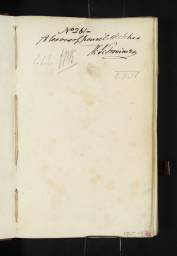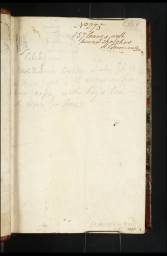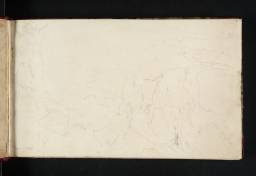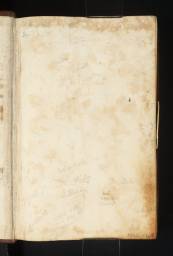Sketchbooks Used on Tour in Yorkshire 1816
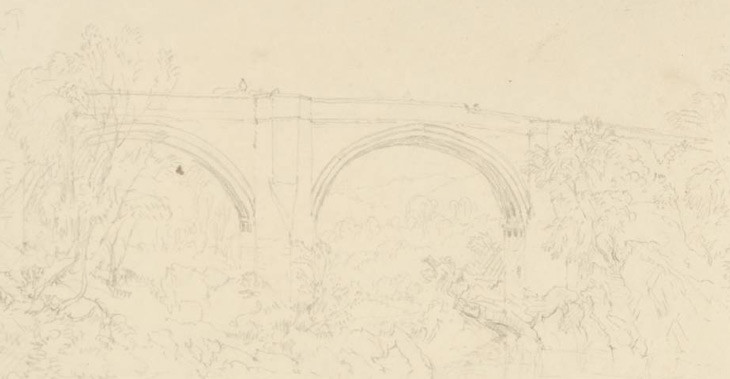
From the entry
These six sketchbooks relate to Turner’s tour of Yorkshire in 1816. Turner named them himself, and numbered them consecutively, defining them as a group. The most immediate primary documentation for the date and the context of this tour is to be found in the diaries of the Royal Academician Joseph Farington. On 15 May 1816 Farington reported that he had been told ‘Turner had been engaged to make drawings for a History of Yorkshire: Longman & Co. to be the Publishers: and that he was to have 3000 guineas for his drawings.’ Two days later Farington added that ‘Turner told me He had made an engagement to make 120 drawings views of various kinds in Yorkshire, – for a History of Yorkshire for which he was to have 3000 guineas. Many of the subjects required, He said, He had now in his possession. He proposed to set off very soon for Yorkshire to collect other subjects.’ This General History of the County of York would, if completed, have been the latest and most ...
References
These six sketchbooks relate to Turner’s tour of Yorkshire in 1816. Turner named them himself, and numbered them consecutively, defining them as a group.
The most immediate primary documentation for the date and the context of this tour is to be found in the diaries of the Royal Academician Joseph Farington. On 15 May 1816 Farington reported that he had been told ‘Turner had been engaged to make drawings for a History of Yorkshire: Longman & Co. to be the Publishers: and that he was to have 3000 guineas for his drawings.’ Two days later Farington added that ‘Turner told me He had made an engagement to make 120 drawings views of various kinds in Yorkshire, – for a History of Yorkshire for which he was to have 3000 guineas. Many of the subjects required, He said, He had now in his possession. He proposed to set off very soon for Yorkshire to collect other subjects.’
This General History of the County of York would, if completed, have been the latest and most ambitiously conceived work of antiquarian topography and regional history by Dr Thomas Dunham Whitaker, on whose literary projects Turner had worked intermittently since 1799. It was to be published in seven volumes. Only the first part, the History of Richmondshire, was published with Turner’s illustrations before Dr Whitaker died in 1821. The 1816 tour furnished much material for these.
Further essential contemporary evidence, relating to the material in the sketchbooks, is a diary kept by Maria Sophia, the wife of Turner’s friend and patron Walter Fawkes of Farnley Hall in Yorkshire.1 The original diaries are lost but the entries relating to Turner were published by A.J. Finberg.2 These record that Turner was included in a family party that left Farnley on Wednesday 17 July 1816, slept overnight at Skipton, and travelled on to Browsholme Hall in Lancashire, the home of Fawkes’s friend and Turner’s sometime patron, Thomas Lister Parker.3 The group stayed a week at Browsholme, making excursions to the nearby Trough of Bowland, left on Wednesday 24 July for Malham and on Thursday 25 July went to see Gordale Scar before returning home. Turner then left the group, as the diary records, and ‘went on a sketching tour’. The other valuable information yielded by Mrs Fawkes’s diaries is that the weather was unremittingly wet. 1816 was known as ‘the year without a summer’ on account of climatic disturbance caused by the eruption of Mount Tambora in the Philippines the previous year. As we shall see, Turner had cause to remark upon the conditions himself.
The itinerary described by Mrs Fawkes is exactly mirrored by what must be the first sketches in the Yorkshire 2 sketchbook. This also records Turner’s journey by coach from London to Leeds;4 the fare was two guineas, and the journey took two days, stopping for dinner at Eaton Socon near Peterborough, sleeping overnight at Grantham and taking breakfast at Doncaster. The sketchbook begins with sketches at Skipton and in the Browsholme area, and the itinerary continues, as Mrs Fawkes relates, to Malham and Gordale. Thereafter a route can be followed via Upper Wharfedale to Wensleydale, Swaledale and Richmond. On 31 July 1816 Turner wrote from Richmond to his friend James Holworthy, telling him that his planned journey had been extended by the visit to Lancashire, and that the ‘Weather [is] miserably wet; I shall be web-footed like a drake, except the curled feather; but I must proceed northwards. Adieu!’ 5
Turner’s itinerary continued north to Greta Bridge, Barnard Castle and into Upper Teesdale to High Force and Cauldron Snout. From there he crossed the High Pennine moors to Appleby. Given the wet conditions this was quite a struggle and he recalled the journey in another letter to Holworthy written from Farnley on 11 September 1816: ‘the passage out of Teesdale leaves everything far behind for difficulty – bogged most completely Horse and its Rider, and nine hours making eleven miles’. Some of the sketches on the route show conspicuous water-staining.6 From Appleby the sketches trace a route through the Lune Gap to Kendal and the head of the River Kent, before exploring Morecambe Bay as far as Ulverston, then crossing the sands to Lancaster and returning to Farnley via the Lune Valley, Kirkby Lonsdale, Ingleton and Skipton.
The core itinerary as documented in the Yorkshire 2 sketchbook is mirrored by sketches in the Yorkshire 4 and Yorkshire 5 sketchbooks. Yorkshire 2 is a thick pocket-book in which Turner made his preliminary and exploratory sketches, or jottings en route, but Yorkshire 4 and Yorkshire 5 are larger, landscape-format books which he reserved for more considered drawings, most of which were presumably destined to form subjects for Whitaker’s projected History. It is not recorded exactly when Turner returned to Farnley but Mrs Fawkes noted that, as usual, the annual shoot began at Farnley on 12 August and all the gentlemen went to the moors. Assuming that Turner arrived the day before, in time for the shoot, and taking the documented points leaving Malham on 25 July and Richmond on 31 July, as well as internal indications in the work, into account the present writer proposed a day-to-day itinerary for the tour in his 1984 book. This is referred to, with the relevant dates, in the detailed entries for individual sketches in the sketchbooks.
Mrs Fawkes’s diaries relate that the Farnley shoot was overshadowed on 13 August when one of the party, her brother-in-law Richard Hawkesworth Fawkes, was injured in a gun accident. Although he seemed tolerably well at first, he worsened rapidly and died early in the morning of the 16th. Thereafter most of the guests dispersed and although Turner stayed on, he wrote from Farnley to W.B. Cooke7 on 28 August that as a result of the accident it was best that he leave for a few days on his ‘Yorkshire trip for your friends the Longmans’.8 He must have gone away again almost immediately for he wrote from Farnley to Holworthy on 4 September to say that he had ‘just returned from part of my Yorkshire sketching trip’ and had ‘finished nearly what I proposed doing this season in Yorkshire’.9 The implication is that he was planning at least one more excursion before leaving. He wrote again to Holworthy from Farnley on 11 September making plans for his departure10, and on Sunday 15 September Mrs Fawkes reported that ‘Mr Turner went away’.
In his 1984 book, the present writer concentrated on the 1816 tour as documented in the Yorkshire 2, Yorkshire 4 and Yorkshire 5 sketchbooks. It is clear, however, that two more sketchbooks in this group, Yorkshire 1 and Yorkshire 3, can also be dated to this year. The date of Yorkshire 1 is proven by a note on D11039; Turner Bequest CXLV 105 of a £5 banknote, numbered 16135 and dated 11 May 1816,11 cashed at Richmond, Yorkshire.12 The same banknote is recorded in Yorkshire 2 (Tate D11370; Turner Bequest CXLV 186a), which covers the July/August part of Turner’s travels including a separate visit to Richmond, and the reference ties the sketchbooks together in a single campaign.
The route indicated by the Yorkshire 1 sketchbook begins at Spofforth, Plompton Rocks and Wetherby and heads east to York. From there Turner headed north-west through Boroughbridge, to Newby Hall, Ripon and Fountains Abbey. Thence he followed the River Ure via West Tanfield, Hackfall, Masham, and Jervaulx to Middleham finishing by including Topcliffe and Knaresborough. This itinerary is exactly mirrored in the larger Yorkshire 3 sketchbook, in more considered drawings, while Turner used the smaller Yorkshire 1 for his exploratory sketches and jottings.
The final sketchbook in this group is Yorkshire 6. This thick pocket-book is largely unused, but contains two series of sketches at either end recording subjects near Farnley and Sutton Bank together with a river expedition under dramatic skies at an as yet unidentified location. The book is connected to the 1816 tour by a sketch-map of places in North Yorkshire.13 On the actual tour itineraries Turner visited some, but not all of the sites marked on the map, but nevertheless one might infer that Turner made the map at least with the Whitaker tour in mind, and the book presumably therefore travelled north with him in 1816.
Among the principal accounts of Farnley and Fawkes may be mentioned Hamilton 2001 and Hill 1988. For sketchbook material relating to Fawkes and Farnley in the present catalogue see Introduction: Farnley Hall and Related Yorkshire Subjects.
John Gage, Collected Correspondence of J.M.W. Turner with an Early Diary and a Memoir by George Jones, Oxford 1980, p.67 no.65. For Holworthy see James Hamilton, ‘Holworthy, James (1781–1841)’, in Oxford Companion, pp.143–4.
At this time W.B. Cooke was publishing Turner’s Southern Coast series of engravings, and from the content of the letter, Turner was correcting proofs while away in Yorkshire. For Cooke see Gillian Forrester, ‘Cooke, William Bernard (1778–1855)’ in Oxford Companion, p.63.
Gage 1980, p.68 no.66. Turner says that he has received a letter from Cooke on Monday, that is 26 August, presumably indicating the date of his return to Farnley. On this occasion he appears to have been away for about a week.
Turner did not sketch Richmond in this sketchbook, but in Yorkshire 3 (D11412; Turner Bequest CXLVI 27).
How to cite
David Hill, ‘Sketchbooks Used on Tour in Yorkshire 1816’, March 2008, revised by David Blayney Brown, April 2013, in David Blayney Brown (ed.), J.M.W. Turner: Sketchbooks, Drawings and Watercolours, Tate Research Publication, December 2013, https://www

